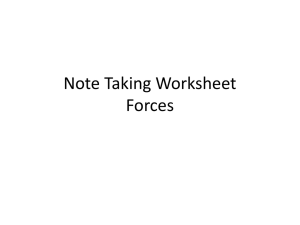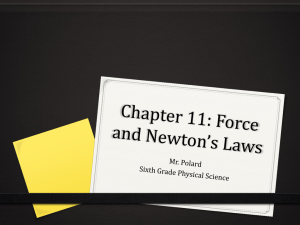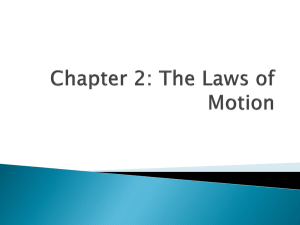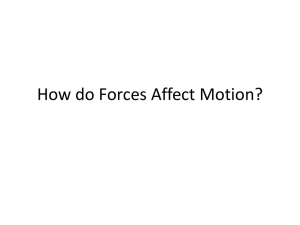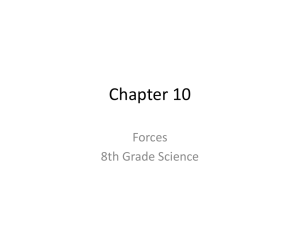Chapter 12 Forces and Motion
advertisement
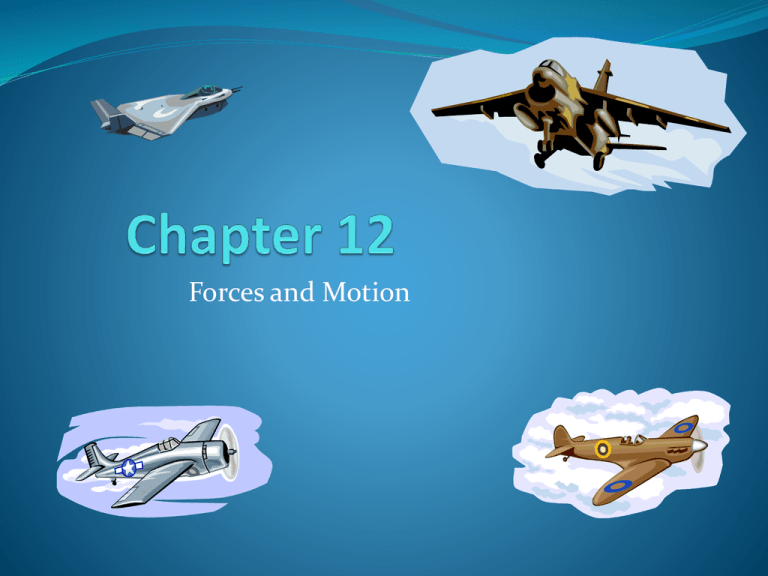
Forces and Motion Chapter 12.1 Forces What is a Force? What are the units of force? It is a push or a pull that acts It is measured in newtons, on an object It can cause a resting object to move, or it can accelerate a moving object by changing the object’s speed or direction. abbreviated a N. One newton is the force that causes a 1-kilogram mass to accelerate at a rate of 1 meter per second each second (1 m/s2) You can use an arrow to represent the direction and strength of a force. 12. 1 Forces Combining Forces What is net force? It is the overall force acting on an object after all the forces are combined. What are balanced forces? When the forces on an object are balanced, the net force is zero and there is no change in the object’s motion. Chapter 12.1 Forces Combining Forces What are unbalanced forces? When an unbalanced force acts on an object, the object accelerates. Chapter 12.1 Forces Friction What is friction? What are the different types It is a force that opposes the motion of objects that touch as they move past each other. Friction acts at the surface where objects are in contact. of Friction? A. static friction B. sliding friction C. Rolling friction D. Fluid friction Chapter 12.1 Forces Static Friction What is Static friction? It is the friction force that acts on objects that are not moving. It is always acts in the direction opposite to that of the applied force. Figure 5a on page 359 Chapter 12.1 Forces Sliding Friction What is sliding friction? It is a force that opposes the direction of motion of an object as it slides over a surface. It is a smaller friction force that static friction Figure 5 B on page 359 Chapter 12.1 Forces Rolling Friction What is rolling friction? It is the friction force that acts on rolling objects. Figure 6 on page 360 Chapter 12.1 Forces Fluid Friction What is fluid friction? It is the force that opposes the motion of an object through a fluid. Chapter 12.1 Forces Gravity What is gravity? It is a force that acts between any two masses. It is an attractive force. Note that the force of gravity does not require objects to be in contact for it to act on them. Earth’s gravity acts downward toward the center of Earth. An upward force usually balances the downward force of gravity. Chapter 12.1 Forces Falling Objects What forces affect the motion What is Terminal Velocity? of an object dropped from the top of a tall building? Gravity causes objects to accelerate downward, whereas air resistance acts in the direction opposite to the motion and reduces acceleration. It is the constant velocity of a falling object when the force of air resistance equals the force of gravity. Chapter 12.1 Projectile Motion What is the path of a ball Air resistance and gravity are moving forward? It is a curved path. What is this curved path? It is the path of projectile motion which is the motion of a falling object (projectile) after it is given an initial forward velocity. the only forces acting on a projectile. The combination of an initial forward velocity and the downward vertical force of gravity causes the ball to follow a curved path. Chapter 12.1 Assessment 1. A force can set an object at rest into motion, or it can accelerate a moving object by changing its speed or direction. 2. Static friction, sliding friction, rolling friction, and fluid friction. 3. It acts opposite the direction of motion and slows the acceleration of a falling object. 4. Downward toward the center of earth. 5. The combination of initial horizontal velocity and downward vertical force causes a projectile to follow a curved path. Chapter 12.1 Assessment 6. The force of static friction is greater than that of sliding friction. The force of sliding friction is generally greater than that of rolling friction. 7. Varying air resistance acting on the leaf results in a fluttering motion. Both coins hit the ground at the same time. 12.2 Newton’s laws of Motion Aristotle Ancient Greek scientist and philosopher 384 B.C. to 322 B.C. He incorrectly proposed that force is required to keep an object moving at constant speed. 12.2 Newton’s laws of Motion Galileo Italian scientist 1564- 1642 By rolling balls down wooden ramps, he studied how gravity produces constant acceleration. He concluded that moving objects not subject to friction or any other force would continue to move indefinitely. 12.2 Newton’s laws of Motion Isaac Newton English scientist 1642 – 1727 First to define mass and force Then introduced his laws of motion 12.2 Newton’s Laws of Motion First law of Motion According to Newton’s first law of motion, the state of motion of an object does not change as long as the net force acting on the object is zero. Thus, unless an unbalanced force acts, on object at rest remains at rest, and an object in motion remains in motion with the same speed and direction. What is inertia? It is the tendency of an object to resist a change in its motion. In other words, an object at rest tends to remain at rest, and an object in motion tends to remain in motion with the same direction and speed. 12.2 Newton’s laws of Motion Second Law of Motion According to Newton’s second law of motion, the acceleration of an object is equal to the net force acting on it divided by the object’s mass. Mass is a measure of the inertia of an object and depends on the amount of matter the object contains. Doubling the mass of an object cuts its acceleration in half. Double the force, the acceleration of the ball doubles. Formula A = F/m Chart on the side board 12.2 Newton’s laws of Motion Math Skills An automobile with a mass of 1000 kilograms accelerates when the traffic light turns green. If the net force on the car is 4000 newtons, what is the car’s acceleration? List your information Show your formula, substitution, work, answer A = 4000/1000 = 4 m/s2 12.2 Newton’s laws of Motion A boy pushes forward a cart of groceries with a total mass of 4.0. kg. What is the acceleration of the cart if the net force on the cart is 60.0 N? A = F/m = 60.0/40.0 = 1.5 m/s2 What is the upward acceleration of a helicopter with a mass of 5000 kg if a force of 10,000 N acts on it in an upward direction? A = f/M = 10,000/5000 = 2 m/s2 12.2 Newton’s laws of Motion An automobile with a mass of 1200 kg accelerates at a rate of 3.0 m/s2 in the forward direction. What is the net force acting on the automobile? F = ma = 1200 x 3 =3600 N A 25-N force accelerates a boy in a wheelchair at 0.5 m/s2. What is the mass of the boy and the wheelchair? M = F/a = 25/.5 = 50 kg 12.2 Newton’s laws of Motion Weight and Mass What is weight? Mass is a measure of the It is the force of gravity acting inertia of an object; weight is a measure of the force of gravity acting on an object. What is your mass? on an object. An object’s weight is the product of the object’s mass and acceleration due to gravity acting on it. W = mg G = 9.8 m/s2 12.2 Assessment 1. According to Newton’s first law of motion, the state of motion of an object does not change as long as the net force acting on the object is zero. 2. a = F/m 3. Mass is a measure of the inertia of an object; weight is a measure of the force of gravity acting on an object. 12.2 Assessment 4. Examples in which objects at rest remain at rest or tend to continue moving (first law) and in which a net force acting on an object causes a change in the object’s state of motion (second law). 5. The heavier steel ball will take longer to reach terminal velocity. A greater speed is needed to produce the air resistance required to balance the steel ball’s greater weight. The steel ball must fall for a longer period of time in order to reach this greater speed. 12.2 Assessment 6. a = F/m = 825/75 = 11 m/s2 7. a = (vf – vi)/t = (4 -0 )/8 = .5 m/s2 F = ma = 85 x .5 = 42.5 N Chapter 12.3 Third law & Momentum Newton’s Third Law What is Newton’s Third Law of Motion? It is whenever one object exerts a force on a second object, the second object exerts an equal and opposite force on the first object. These two forces are called action and reaction forces. Chapter 12.3 Third law & Momentum Momentum What is momentum? It is the product of an object’s mass and its velocity. An object has a large momentum if the product of its mass and velocity is large. Momentum Formula Momentum = Mass x Velocity Chart on the Board Chapter 12.3 Third Law & Momentum Conservation of Momentum What is the law of conservation of momentum? If no net force acts on a system, then the total momentum of the system does not change. In a closed system, the loss of momentum of one object equals the gain in momentum of another object, momentum is conserved. Chapter 12.3 Third Law & Momentum Data Analysis Page 377 1. At t = 0; the ball has zero momentum before it is released. 2. at t = 2.5 s; about 6.5 kgm/s 3. mv = 3.25 kg=m/s, V = 3.25/.25 V = 13 m/s upward Chapter 12.3 Assessment 1. Whenever one object exerts a force on a second object, the second object exerts an equal and opposite force on the first object 2. Momentum = Mass x Velocity 3. The object involved must be part of a closed system. 4. Because the speeds are equal, the eagle’s greater mass gives it more momentum. 5. It is incorrect because it is the force of the water against the oars that propels the boat forward. The oars pushing against the water is the action force, and the water pushing back against the oars is the reaction force. Chapter 12.3 Assessment 6. As you walk, you bend your foot and push off against the ground. This action force produces the reaction force of the ground pushing against your shoe. The reaction force pushes you forward. 7. When you jump, you push against the canoe. However, the canoe also moves in the opposite direction of your jump. Because the canoe moves away, it produces a smaller reaction force on you. This small reaction force is not strong enough to propel you to the river bank. Chapter 12.4 Universal Forces Universal Forces What are the four universal forces? Electromagnetic Forces Strong Nuclear Force Weak Nuclear Force Gravitational Force Chapter 12.3 Universal Forces Electromagnetic Forces Electric Forces What are the two different Electric forces act between aspects of the electromagnetic force? They are Electric and Magnetic force. Electric force and magnetic force are the only forces that can both attract and repel. charged objects or particles such as electrons and protons. Objects with opposite charges – positive and negative – attract one another. Objects with like charges repel one another. Chapter 12.4 Universal Forces Magnetic Forces Magnets have two poles, north and south, that attract each other. Two poles that are alike repel each other. Opposite poles attract each other. Chapter 12.4 Universal Forces Nuclear Forces What is the Strong Nuclear Force? It is a powerful force of attraction that acts only on the neutrons and protons in the nucleus, Holding them together. It overcomes the electric force of repulsion that acts among the protons in the nucleus. This force acts over only extremely short distances, it is 100 times stronger than the electric force of repulsion at these distances. Chapter 12.4 Universal Forces Weak Nuclear Force The weak force is weaker in strength than the strong nuclear force. It is an attractive force that acts only over a short range. (less than the range of the strong nuclear force) It is involved in certain types of radioactive processes. Chapter 12.4 Universal Forces Gravitational Force What is gravitational force? It is an attractive force that acts between any two masses. Newton’s law of universal gravitation states that every object in the universe attracts every other object. Gravity is the weakest universal force, but it is the most effective force over long distances. What are two factors affecting gravitational force? Mass and Distance Larger the mass, larger gravitational force Increasing the distance between the masses significantly reduces the gravitational force. Chapter 12.4 Universal Forces Chapter 12.4 Universal Forces The Earth, Moon, and Tides Earth’s gravitational If you have spent time at the attraction keeps the moon in a nearly circular orbit around Earth. A centripetal force is a centerdirected force causes a continuously changes the direction of an object to make it move in a circle. seashore, you have probably noticed that the level of the tide changes throughout the day. The gravitational pull from the moon produces two bulges in Earth’s oceans. Side of Earth closest to moon Side of Earth farthest to moon Chapter 12 Universal Forces 1. Electromagnetic force is the only force that vban both attract and repel. 2. The strong nuclear force acts within the nucleus to hold it together. 3. According to Newton’s law of universal gravitation, every object in the universe attracts every other object. 4. Friction with the atmosphere slows artificial satellites in low orbit. 5. Earth’s gravitational attraction acts as a centripetal force on the moon. Chapter 12 Universal Forces 6. It would gradually be pulled closer to Earth and eventually fall out of orbit. 7. According to Newton’s third law, whenever one object exerts a force on a second object, the second object exerts an equal and opposite force on the first object. Newton’s law of gravitation is a special case of this in which the force is gravity. Chapter 12 Forces and Motion Time for a test on Forces and Motion!


